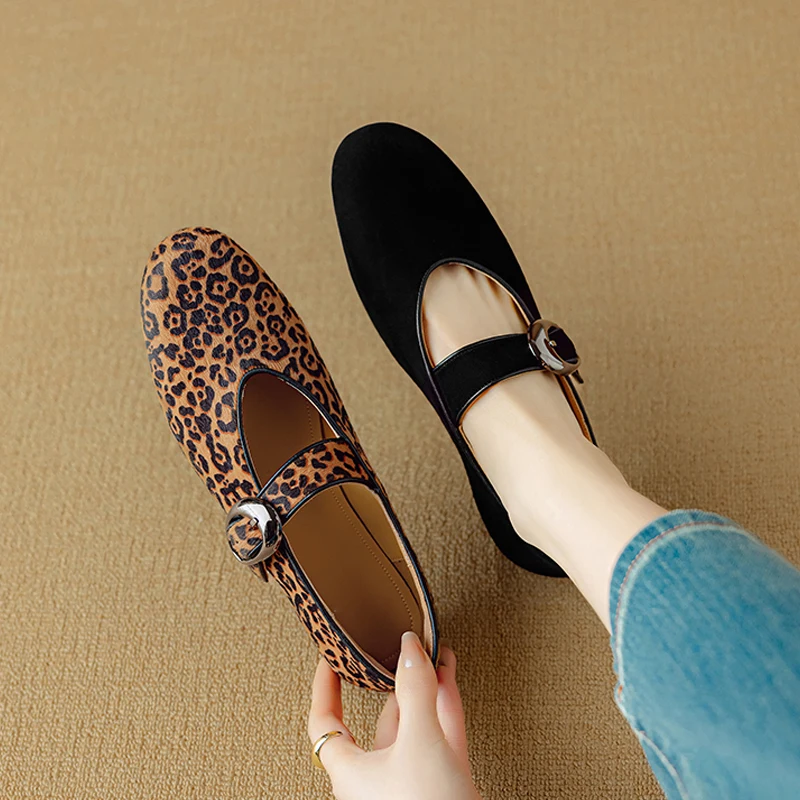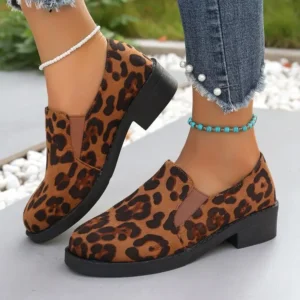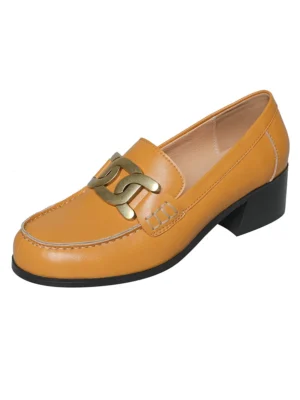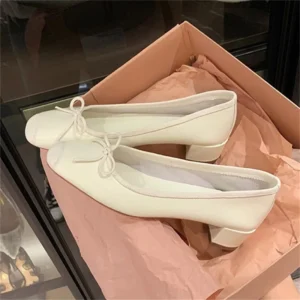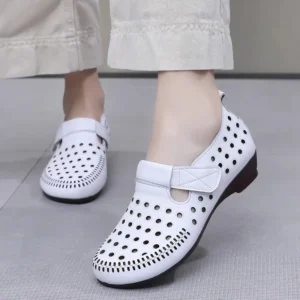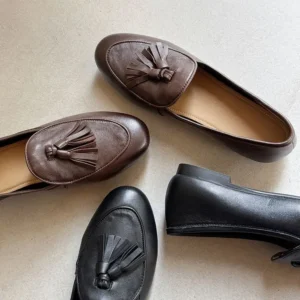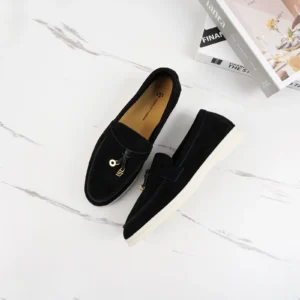Understanding Leather and Suede Loafer Materials
Material Properties and Origins
When investing in premium footwear, understanding what you’re walking on is the first step to proper care. Leather and suede might seem similar at first glance, but their properties and care requirements differ significantly.
Leather used in quality loafers typically comes from the top layers of animal hide. Full-grain leather preserves the natural surface of the hide with all its unique characteristics, while top-grain leather has had the uppermost layer slightly buffed to reduce imperfections. These premium women’s leather flat loafers benefit from leather’s natural durability and adaptability to your feet over time.
Suede, meanwhile, is created from the inner splits of leather with the surface brushed to create its signature soft, napped finish. The resulting material used in women’s suede flat loafers has a velvety texture that’s immediately recognizable but requires special attention to maintain.
The thickness of premium leather in quality loafers typically ranges from 1.2-2.0 mm, providing durability without stiffness. Suede is generally thinner, usually measuring between 0.8-1.4 mm, contributing to its flexibility and lighter weight.
These fundamental differences in structure—leather’s dense, smooth surface versus suede’s raised fibers—directly impact how each material responds to wear, elements, and cleaning efforts.
How Material Differences Impact Care Needs
Understanding the unique characteristics of each material helps explain why they require different care approaches:
Durability Factors:
– Leather has natural resistance to abrasion and can withstand more robust cleaning methods
– Suede’s raised fibers make it more vulnerable to scuffing and flattening, requiring gentler handling
Breathability Considerations:
– Leather typically has lower porosity, making it more resistant to water but potentially less breathable
– Suede’s structure allows for excellent airflow but also makes it more susceptible to absorbing moisture
Element Susceptibility:
– Leather can often repel light moisture when properly conditioned
– Suede absorbs water readily and shows water spots more dramatically
Aging Characteristics:
– Leather develops a desirable patina over time that enhances its appearance
– Suede tends to show wear patterns more quickly, particularly in high-contact areas
The fundamental differences between leather and suede care requirements stem directly from these material properties. What keeps leather looking its best can actually damage suede, and vice versa—making material-specific care essential for preserving your investment.
Essential Care Products for Premium Loafers
Must-Have Tools and Products for Leather Loafers
Creating a proper leather care kit is an investment that pays dividends in extended loafer life. Here are the essentials:
Horsehair Brushes: You’ll need two types—a softer brush for regular dust removal and gentle cleaning, and a firmer brush for more thorough cleaning and polish distribution. The natural horsehair bristles are gentle enough for fine leather while effectively removing debris.
Microfiber Cloths: Not all cloths are created equal. Look for lint-free, high-quality microfiber that won’t leave residue behind. These are essential for applying products and buffing to a shine.
Leather Cleaner: Choose pH-balanced formulations specifically designed for fine leather. Harsh chemicals and household cleaners can strip natural oils and damage the finish.
Leather Conditioner/Cream: Match your conditioner to your leather type. Lighter formulations work for regularly maintained loafers, while drier leather may need richer conditioning creams.
Polish (When Appropriate): For loafers where shine is desired, select a polish matching your leather’s color. Cream-based polishes nourish while adding subtle luster.
Waterproofing Products: Silicone-free waterproofing sprays or waxes provide protection without compromising leather’s breathability.
Cedar Shoe Trees: Perhaps the most underrated tool, properly fitted cedar shoe trees absorb moisture, maintain shape, and prevent creasing. The investment in quality best products for loafer care will pay off through significantly extended footwear life.
Must-Have Tools and Products for Suede Loafers
Suede care requires specialized tools designed specifically for its delicate napped texture:
Suede Brush: Unlike leather brushes, quality suede brushes feature both brass wire and rubber components. The brass bristles gently raise and restore flattened nap, while rubber components help remove surface dirt without damaging fibers.
Suede Eraser: Made from crepe rubber or similar materials, these erasers lift stains and marks by gently pulling them away from the fibers—something ordinary erasers cannot do safely.
Specialized Suede Cleaners: Liquid cleaners formulated for suede use surfactants that lift dirt without saturating fibers. Never substitute leather cleaners, as they can mat suede’s texture permanently.
Suede Protector Sprays: These create an invisible barrier that repels moisture and stains while allowing the material to breathe. Look for formulations specifically stating they’re safe for suede.
Cedar Shoe Trees: Just as with leather, proper shoe trees help maintain shape while wicking away moisture—particularly important for suede, which can be more difficult to reshape if deformed.
The specialized nature of these tools reflects suede’s unique properties. Using leather products on suede can cause irreversible damage, making proper suede loafer care tools an essential investment rather than an optional expense.
Comprehensive Leather Loafer Care Routine
Daily and Weekly Maintenance for Leather
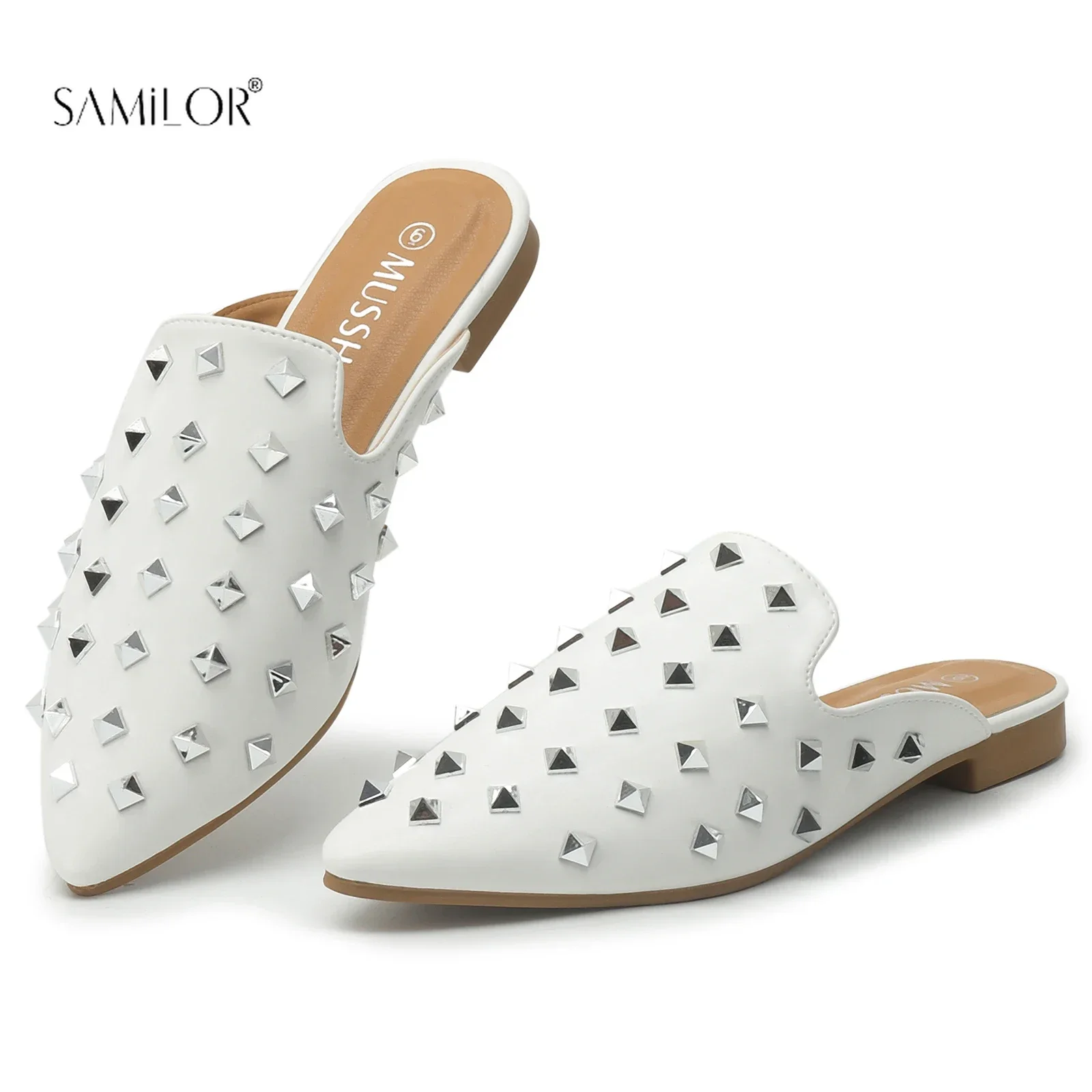
Consistent daily and weekly care prevents most serious leather issues before they develop:
Post-Wear Routine (5 minutes)
1. Wipe loafers with a soft cloth to remove surface dust and debris
2. Check for any spots that need immediate attention
3. Insert cedar shoe trees while leather is still warm from wearing
4. Allow loafers to rest in a well-ventilated area away from direct heat
Weekly Maintenance (15 minutes)
1. Remove shoe trees and inspect loafers thoroughly for issues
2. Using your soft horsehair brush, brush the entire surface in gentle, straight strokes
3. Pay special attention to seams and welt areas where dirt accumulates
4. For light scuffs, gentle brushing often restores appearance
5. Reinsert shoe trees to maintain shape
The importance of rotation can’t be overstated. Even the finest pristine leather loafers need 24-48 hours to fully dry between wearings. Maintaining at least two pairs of classic penny loafers or similar styles allows for proper rest while extending the life of both pairs.
Deep Cleaning Leather Loafers
When weekly maintenance isn’t enough to address buildup, follow this thorough deep cleaning process:
Step 1: Preparation
1. Remove laces if present
2. Brush thoroughly to remove surface dirt
3. Stuff loafers with paper to maintain shape during cleaning
4. Place over newspaper or cloth to catch drips
Step 2: Cleaner Application
1. Always test cleaner on an inconspicuous area first
2. Dampen (don’t soak) a cloth with leather cleaner
3. Apply to a small section, working in gentle circular motions
Step 3: Cleaning Technique
1. Work in small sections, using minimal product
2. Avoid saturating the leather, which can cause staining or warping
3. Pay special attention to heavily soiled areas like toe creases and heel edges
4. Wipe away excess cleaner before it dries
Step 4: Drying
1. Allow loafers to air dry naturally away from direct heat or sunlight
2. Expect 3-6 hours drying time in normal indoor conditions
3. Never use hair dryers or heaters to speed drying
The frequency of deep cleaning depends on wear patterns, but most quality loafers benefit from thorough cleaning 3-4 times per year. Regular maintenance is key to long-term leather footwear care and prevents the need for more aggressive cleaning that might damage the leather.
Conditioning and Moisturizing Leather Correctly
Conditioning is perhaps the most crucial step in leather care, as it replaces natural oils that prevent cracking and maintain flexibility:
Conditioning Essentials:
– Choose conditioners formulated for your specific leather type
– Apply conditioner when leather feels dry or stiff, typically every 1-3 months
– Always condition after deep cleaning, as cleaning removes some natural oils
Application Technique:
1. Ensure leather is clean and completely dry
2. Apply a small amount of conditioner to a cloth (not directly to leather)
3. Work in thin, even layers using gentle circular motions
4. Start at toe and work toward heel, ensuring even coverage
5. Pay special attention to creased areas where drying occurs first
6. Allow 15-30 minutes for initial absorption
7. Wipe away any excess with a clean cloth
Post-Conditioning:
– Allow 8-12 hours for complete absorption before wearing
– Buff with a clean cloth for a subtle luster
– For particularly dry leather, a second light application may be necessary
Quality leather penny loafers can develop microscopic cracks when leather dries out, which eventually become visible damage. Regular conditioning prevents this by maintaining leather’s natural flexibility and resilience.
Polishing and Protecting Leather Loafers
The final steps in leather care involve enhancing appearance and creating protective barriers:
When to Polish:
Polish is appropriate for smooth leather loafers when shine is desired. Some casual styles and certain finishes look best with minimal or no polish.
Polishing Process:
1. Ensure loafers are clean, dry, and properly conditioned
2. Select polish that exactly matches your leather color
3. Apply sparingly with a cloth or dedicated applicator in circular motions
4. Allow to dry to a haze (typically 5-10 minutes)
5. Buff with a clean cloth using quick back-and-forth motions
6. For higher shine, repeat with minimal additional polish
Waterproofing Application:
1. Choose protection products formulated specifically for fine leather
2. Apply in a well-ventilated area
3. Hold spray 6-8 inches from surface and apply evenly
4. Allow to dry completely (usually 24 hours) before wearing
5. Reapply every 15-20 wearings or when water stops beading on surface
The molecular structure of quality protection products creates an invisible barrier that repels moisture while allowing leather to breathe. This balance is essential for extending the life of your leather and suede footwear.
Comprehensive Suede Loafer Care Routine
Daily and Weekly Maintenance for Suede
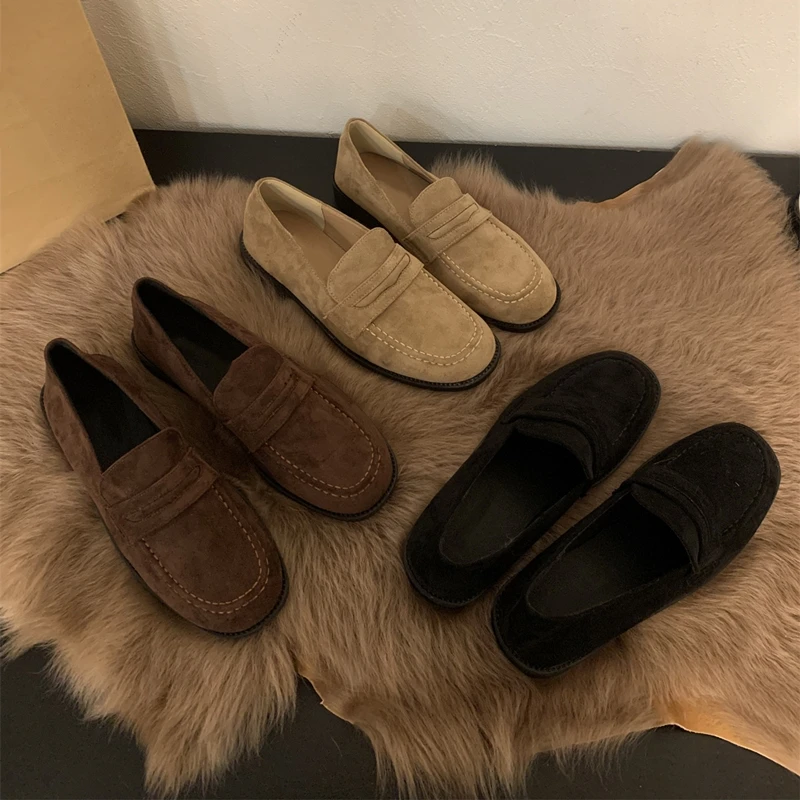
Suede requires consistent attention to maintain its distinctive texture and appearance:
Daily Care (3-5 minutes):
1. Brush gently with a suede brush in the direction of the nap immediately after wearing
2. Use light, consistent strokes rather than aggressive brushing
3. Focus extra attention on areas that contacted surfaces (toe, heel)
4. Insert cedar shoe trees while still warm from wearing
Weekly Maintenance (10-15 minutes):
1. Perform a more thorough brushing of the entire surface
2. Use the brass-bristled portion of your suede brush on stubborn areas
3. Brush in a cross-hatch pattern for areas with flattened nap
4. Check for spots or stains that might need specific treatment
Proper rotation is even more critical for suede penny loafers than for leather, as suede needs ample time to release absorbed moisture. Alternating between pairs allows complete drying and helps nap recover between wearings.
Proper Cleaning Techniques for Suede Loafers
When suede requires more than routine brushing, follow these steps for effective cleaning:
Step 1: Preliminary Dry Cleaning
1. Brush thoroughly with suede brush to remove loose dirt
2. Work in the direction of the nap initially
3. For matted areas, use brass bristles with light pressure
Step 2: Stain Treatment
1. For dry marks, gently rub with suede eraser
2. Work in one direction rather than circular motions
3. Brush area afterward to restore nap
Step 3: Spot Cleaning Techniques
– For water-based stains: Allow to dry completely, then brush
– For oil stains: Blot (don’t rub) excess immediately, apply absorbent powder like cornstarch, let sit overnight, then brush away
– For mud: Allow to dry completely before brushing away
Step 4: Using Liquid Cleaners (When Necessary)
1. Use only cleaners specifically formulated for suede
2. Apply to a clean cloth first, not directly to suede
3. Work in small sections with minimal moisture
4. Allow to dry completely away from heat sources
5. Brush gently to restore nap once dry
The key difference between leather and suede cleaning is moisture management. While leather can handle some dampness during cleaning, suede’s texture can be permanently altered by excess moisture.
Protecting and Waterproofing Suede Effectively
Creating protective barriers is especially important for suede’s vulnerable texture:
Protector Application:
1. Choose spray protectors specifically formulated for suede
2. Clean and brush suede thoroughly before protecting
3. Hold protector spray 6-8 inches from surface
4. Apply in light, even coats rather than saturating
5. Cover entire surface, including seams and edges
6. Allow to dry completely between coats (typically 30-60 minutes)
7. Apply a second light coat for maximum protection
Protection Guidelines:
– Apply protector to new suede loafers before their first wear
– Reapply after cleaning or every 15-20 wearings
– Increase application frequency during wet seasons
– Even with protection, avoid wearing in heavy rain or snow
Modern nano-protection formulas create a molecular barrier around individual suede fibers, allowing them to repel liquids while maintaining breathability. Understanding how to properly protect suede loafers from water dramatically extends their wearable life.
Restoring and Reviving Tired Suede
Even well-maintained suede can eventually lose its characteristic texture and vibrancy:
Diagnosing Common Issues:
– Flattened nap: Areas appear darker and smoother than surrounding suede
– Stubborn stains: Discoloration persists after basic cleaning
– Fading: Overall dulling of color and appearance
– Water damage: Stiff texture or watermarks
Restoration Techniques:
1. Steam Treatment (use caution):
– Hold suede 6-8 inches from steam source
– Apply steam briefly, then immediately brush to lift nap
– Work in small sections rather than steaming entire area at once
Deep Brushing:
– Use brass bristles with slightly more pressure than routine brushing
– Brush in multiple directions to fully lift nap
– Follow with rubber portion of brush to smooth and align fibersColor Refreshment:
– For minor fading, vigorous brushing often reveals deeper color
– For significant fading, consider professional color restoration
Recognizing when to seek professional help is important. If home restoration attempts don’t yield results, professional suede specialists have additional techniques available. Understanding these differences helps explain why suede and leather care require such distinct approaches.
Addressing Common Loafer Problems: A Comparative Approach
Treating Stains and Spills on Both Materials
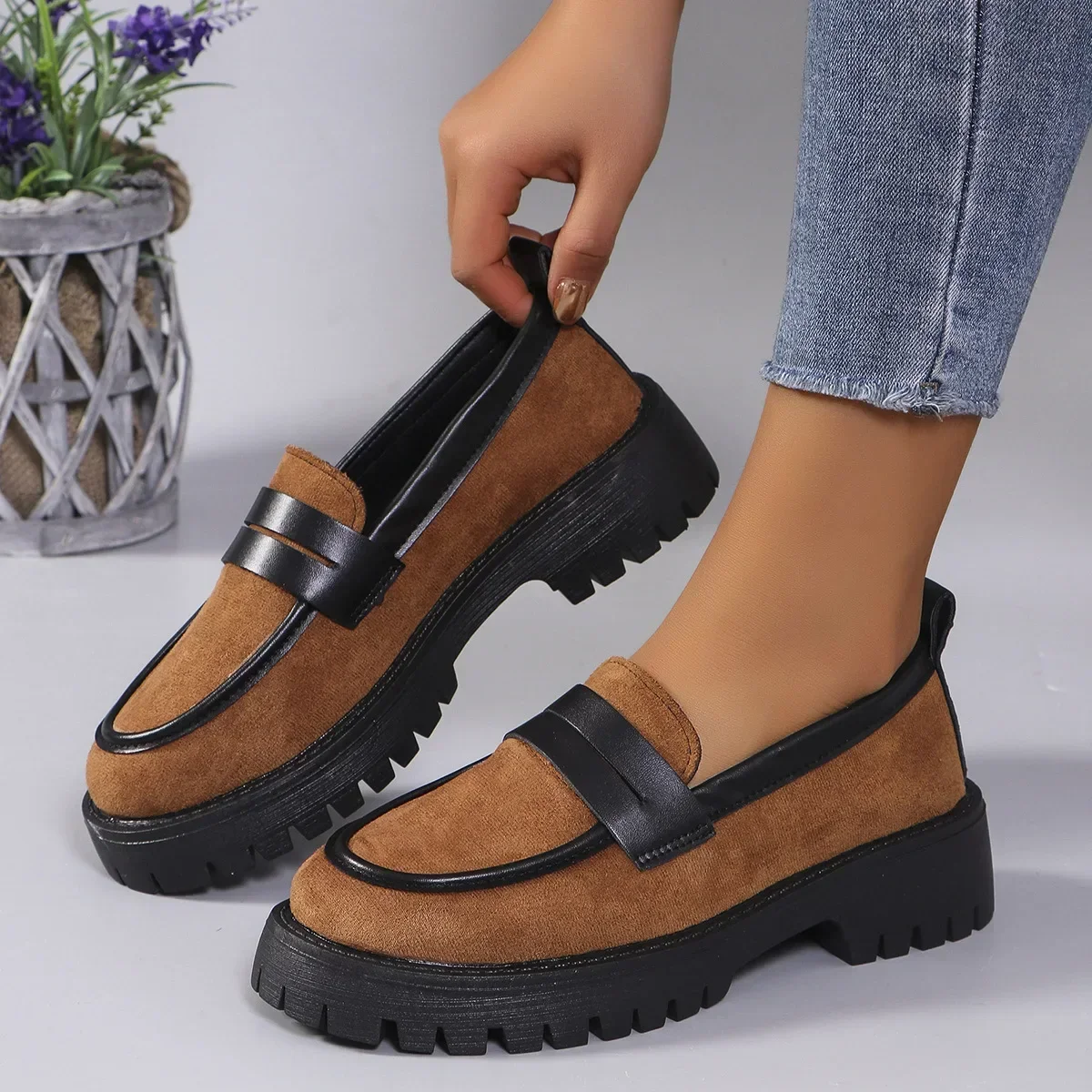
Different materials require completely different approaches to the same problems:
| Stain Type | Leather Treatment | Suede Treatment | Success Rate |
|---|---|---|---|
| Water Spots | Wipe immediately with cloth, follow with conditioner | Allow to dry completely, then brush with suede brush | Leather: 90% Suede: 75% |
| Oil/Grease | Blot excess, apply cornstarch to absorb, clean with leather cleaner | Blot excess, apply cornstarch overnight, brush away, repeat if needed | Leather: 80% Suede: 60% |
| Salt Stains | Wipe with cloth dampened with water/vinegar solution (1:1), condition afterward | Create solution of water and white vinegar (9:1), apply lightly with cloth, dry, brush | Leather: 85% Suede: 70% |
| Ink | Treat immediately, alcohol on cotton swab, gentle blotting, condition after | Professional cleaning typically required for best results | Leather: 50% Suede: 30% |
The emergency response timing differs significantly as well. For leather, immediate action with appropriate cleaning is often beneficial. For suede, allowing some stains (particularly water) to dry completely before treatment often yields better results.
When caring for classic leather loafers for women, responding quickly to stains dramatically improves outcomes, especially for oily substances that can permanently penetrate leather if left untreated.
Dealing with Scuffs and Physical Damage
Physical damage requires material-specific repair approaches:
Leather Scuff Repair:
1. Clean the affected area thoroughly
2. For minor surface scuffs, conditioning often restores appearance
3. For deeper scuffs, matching cream polish can fill and blend damage
4. Apply in thin layers, building up gradually
5. For color loss, leather color restorers matched to your shade can help
Suede Scuff Management:
1. Gently brush with suede brush to raise fibers
2. For compressed areas, use brass bristles with light pressure
3. For stubborn scuffs, very lightly use a fine-grit emery board
4. Always brush after any treatment to restore consistent texture
Edge and Heel Wear:
– Leather: Edge dressing or matching polish can conceal minor wear
– Suede: More challenging to address at home, often requires professional attention
Special consideration should be given to patterned styles like leopard print loafers, where repairs need to match not just color but also pattern elements. For significant damage to either material, professional repair is often the most cost-effective solution long-term.
Strategic Loafer Care: Beyond Basic Maintenance
Proper Storage Techniques for Extended Loafer Life
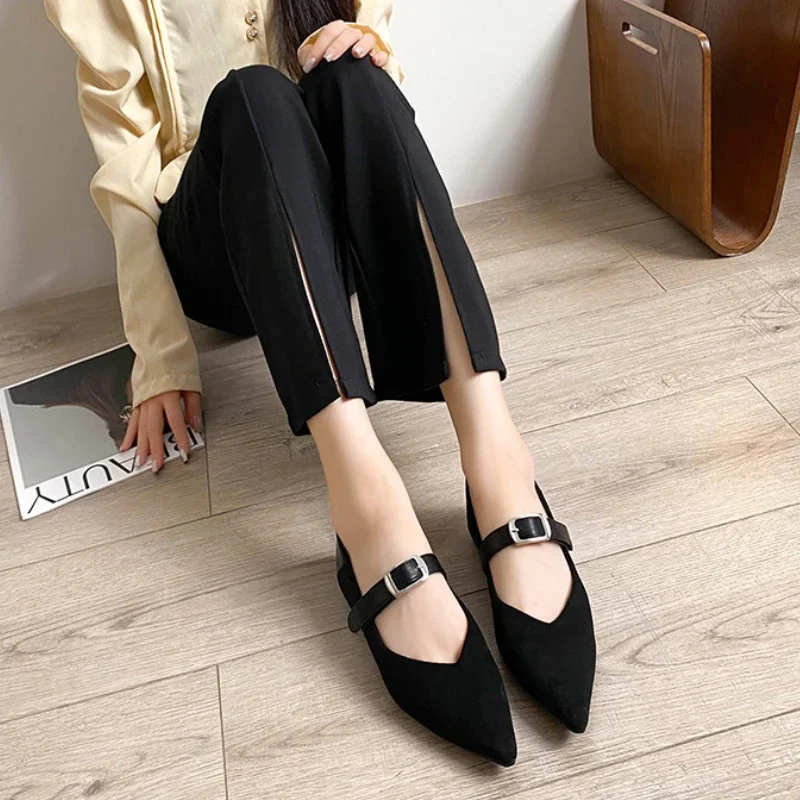
How you store your loafers between wearings is just as important as how you clean them:
Optimal Environment:
– Temperature: 60-80°F (15-27°C)
– Humidity: 40-60% (too dry causes leather cracking; too humid promotes mold)
– Air circulation: Essential for preventing odors and mildew
– Light exposure: Minimal to prevent fading and drying
Cedar Shoe Tree Benefits:
– Absorbs moisture from interior
– Maintains shape and prevents creasing
– Cedar oils naturally deodorize
– Proper fit is crucial: should slide in with gentle resistance
Dust Protection Options:
– Cotton dust bags allow breathability while protecting from dust
– Individual bags prevent color transfer between pairs
– If bags unavailable, breathable cotton pillowcases work as alternatives
– Never store in plastic, which traps moisture
Position Guidelines:
– Store on shelving rather than stacked
– Keep at least 1” between pairs to allow airflow
– Avoid hanging by heels, which can distort shape
– Keep away from exterior walls which may transfer dampness
Long-Term Storage Preparation:
– Clean and condition leather thoroughly before extended storage
– Clean and protect suede completely
– Insert cedar shoe trees
– Place in cotton dust bags
– Check occasionally for issues even during storage
Women's Comfortable Flat Loafers, Women's Leopard Print Loafers, Women's Low Heel Loafers
$82.50 Select options This product has multiple variants. The options may be chosen on the product pageWomen's Block Heel Loafers, Women's Heeled Penny Loafers, Women's Monk Strap Loafers
$194.04 Select options This product has multiple variants. The options may be chosen on the product pageWomen's Block Heel Loafers, Women's Square Heel Loafers, Women's Square Toe Flat Loafers
Price range: $73.61 through $86.41 Select options This product has multiple variants. The options may be chosen on the product pageWomen's Comfortable Flat Loafers, Women's Leather Flat Loafers, Women's Round Toe Flat Loafers
$124.88 Select options This product has multiple variants. The options may be chosen on the product pageWomen's Black Flat Loafers, Women's Black Penny Loafers, Women's Classic Tassel Loafers
$194.28 Select options This product has multiple variants. The options may be chosen on the product pageWomen's Loafer Mules, Women's Suede Flat Loafers
$190.23 Select options This product has multiple variants. The options may be chosen on the product page
Seasonal Care Adjustments for Different Environments
Environmental conditions dramatically affect loafer care requirements:
Summer Adaptations:
– Increase conditioning frequency for leather to prevent heat drying
– Apply additional protection to suede to guard against sudden summer showers
– Allow extra drying time between wearings due to increased foot perspiration
– Consider anti-bacterial treatments for loafer interiors during humid periods
Winter Strategies:
– Apply additional waterproofing to both materials before winter
– Wipe down leather with damp cloth after exposure to salt
– Allow snow-exposed suede to dry completely before brushing away salt residue
– Use dedicated shoe trees for each pair during high-moisture seasons
Transitional Seasons:
– Spring: Deep clean both materials to remove winter buildup
– Fall: Apply fresh protection before wet weather begins
Travel Considerations:
– Pack shoe trees for trips longer than 2-3 days
– Use breathable bags rather than plastic for packing
– Allow loafers to acclimate to new climate before wearing
– Bring compact care kit for extended trips
Understanding how different materials respond to seasonal changes helps you anticipate and prevent potential damage before it occurs.
Professional Maintenance: When to Seek Expert Help
While regular home care is essential, certain situations call for professional intervention:
Signs DIY Care Is Insufficient:
– Deep stains that haven’t responded to home treatments
– Structural issues like loose stitching or sole separation
– Significant color loss or fading
– Water damage that has caused stiffening or warping
– Persistent odors that cedar and cleaning haven’t resolved
Professional Services Available:
– Deep cleaning using commercial-grade equipment
– Color restoration and dying
– Restitching and structural repairs
– Resoling and heel replacement
– Stretching and reshaping
Finding Qualified Specialists:
– Look for cobblers specializing in premium footwear
– Ask about experience with specific materials
– Request examples of similar work they’ve completed
– Inquire about processes and products used
Questions Before Service:
– “What exactly will be done to address the issue?”
– “What products will be used on my loafers?”
– “What is the expected outcome?”
– “Is there any risk to the material or structure?”
For well-maintained premium loafers, professional deep cleaning every 12-18 months complements regular home care and addresses issues before they become significant problems.
Direct Comparison: Leather vs. Suede Loafer Maintenance
Care Effort and Investment Comparison
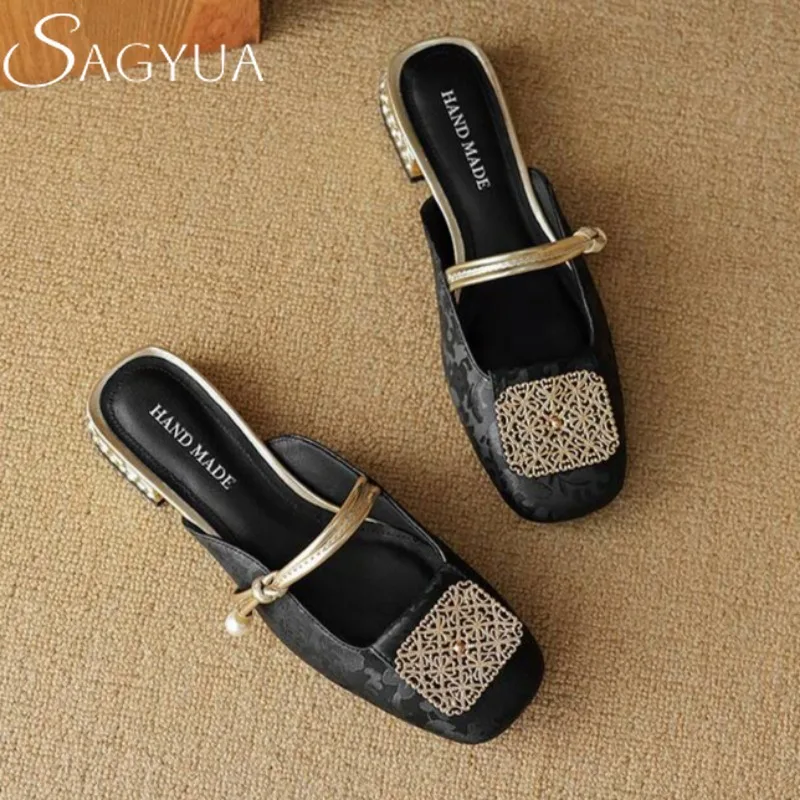
Understanding the relative maintenance requirements helps inform future purchasing decisions:
| Care Aspect | Leather Loafers | Suede Loafers |
|---|---|---|
| Weekly Time Commitment | 10-15 minutes | 15-20 minutes |
| Basic Care Kit Cost | $40-75 | $35-70 |
| Skill Level Required | Beginner to Intermediate | Intermediate |
| Care Frequency | Weekly brushing; conditioning every 1-3 months | Weekly brushing; protection every 15-20 wears |
| Professional Service Frequency | Every 12-18 months recommended | Every 12 months recommended |
| Stain Difficulty Level | Moderate | High |
| Average Annual Maintenance Cost | $50-100 | $60-120 |
Both materials require commitment to maintain properly, but suede generally demands more frequent attention and presents greater challenges when problems arise. For those seeking lower-maintenance options, classic flat loafers in leather often provide the best balance of style and care requirements.
Material Longevity with Proper Care
With appropriate maintenance, premium loafers of both materials can provide years of comfortable wear:
Leather Longevity Markers:
– Well-maintained leather loafers typically remain wearable for 5-10+ years
– Leather develops character over time while maintaining structural integrity
– Proper care allows leather to age gracefully with developing patina
– Recraftable leather loafers can have soles replaced multiple times, extending life
Suede Longevity Markers:
– Quality suede loafers with diligent care typically remain attractive for 3-7+ years
– Suede tends to show age more quickly, particularly in high-stress areas
– Regular brushing and protection significantly extend aesthetic lifespan
– Professional cleaning can rejuvenate suede beyond what’s possible at home
Value Retention Comparison:
– Well-maintained leather typically retains better resale value
– Leather tends to maintain its structural integrity longer
– Suede often requires more frequent replacement despite careful maintenance
The care/longevity relationship is direct and measurable—studies have shown that proper leather care can extend functional life by 300-400% compared to neglected footwear.
Advanced Loafer Care Tips for Enthusiasts
Customized Care for Specialty Leather and Suede Types
Beyond basic leather and suede, specialty variations require tailored care approaches:
Patent Leather Care:
– Avoid oil-based products which can break down the glossy finish
– Clean with gentle soap solution and microfiber cloth
– Restore shine with products specifically for patent finishes
– Prevent cracking by avoiding extreme temperature changes
Burnished Leather Maintenance:
– Preserve gradient coloring with matching polish applied carefully to each zone
– Test products on inconspicuous areas first
– Use minimal product to avoid buildup in color transition areas
Exotic Suede Varieties:
– Ultra-soft suede requires extra-soft brushes and gentler technique
– Colorful suede needs protection from UV exposure to prevent fading
– Textured suedes with longer nap require brushing in consistent directions
For loafers with decorative elements like monk strap designs, additional care is needed around hardware and buckles, which can create wear points and collect moisture or polish residue.
Eco-Friendly and Natural Care Alternatives
For environmentally conscious footwear owners, several natural alternatives provide effective care:
| Care Need | Natural Alternative | Effectiveness | Best Used For |
|---|---|---|---|
| Leather Conditioning | Pure beeswax or shea butter | High (80-90%) | Dry leather needing deep conditioning |
| Leather Cleaning | White vinegar dilution (1:4 with water) | Medium (70%) | Light cleaning of smooth leather |
| Leather Polishing | Banana peel interior (rub and buff) | Medium (65%) | Quick shine enhancement |
| Suede Cleaning | Bread crust gentle rubbing | Medium (60%) | Light surface dirt on suede |
| Odor Control | Cedar blocks, baking soda overnight | High (85%) | Interior freshening |
When to Avoid Natural Alternatives:
– For deep stains requiring targeted chemical action
– When immediate results are needed (natural methods often work more slowly)
– On very expensive or rare leathers without testing first
– When dealing with mold or mildew, which require specific antifungal treatments
Natural products often work best as maintenance rather than problem-solving solutions, and results may vary based on leather type and condition.
Frequently Asked Questions About Loafer Care
Can I use the same products on both leather and suede loafers?
No. Leather products often contain oils and conditioners that will mat and damage suede’s napped surface. Always use material-specific products formulated for either leather or suede.
How often should I clean my loafers if I wear them daily?
Daily light brushing, weekly more thorough cleaning, and deep cleaning every 2-3 months. However, never wear the same pair daily—rotation between multiple pairs significantly extends the life of all your loafers.
What’s the most important care step for preserving leather loafers?
Conditioning is the most critical care step. Leather needs moisture replacement to prevent cracking and maintain flexibility. Regular conditioning prevents most serious leather problems before they begin.
Are expensive care products significantly better than budget options?
Mid-range and premium products typically contain higher quality ingredients with fewer fillers and silicones. While the most expensive isn’t always necessary, avoiding the cheapest options generally results in better long-term outcomes and may actually be more economical over time.
How should I handle completely soaked leather or suede loafers?
For leather: Blot excess moisture, insert shoe trees, and allow to dry slowly away from direct heat for 24-48 hours. Clean and condition once completely dry.
For suede: Blot excess moisture, insert shoe trees, stuff with paper if severely wet, replace paper as it becomes damp, and allow to dry completely for 24-48 hours. Once dry, brush thoroughly to restore nap.
Can household products safely clean premium loafers?
Most household products are too harsh or inappropriate for fine footwear. Common products like dish soap, alcohol, and general cleaners can strip oils, damage finishes, and alter colors. Always use cleaners specifically formulated for premium footwear.
What’s the best way to prevent creases in leather loafers?
Use properly fitted shoe trees whenever loafers aren’t being worn, rotate between multiple pairs, and utilize a shoe horn when putting loafers on to prevent heel collapse. Quality shoe trees are the single most effective tool for preventing creasing.
How can I maintain the color vibrancy in suede loafers?
Protect from UV exposure, brush regularly to remove surface dirt that dulls appearance, use suede-specific protectors that include color protection, and address any stains immediately before they set. For significant fading, professional color restoration may be necessary.
By adhering to these material-specific care routines, your premium Artisan Haul loafers will remain beautiful and functional for years to come, making them not just a purchase but a long-term investment in quality and style.

